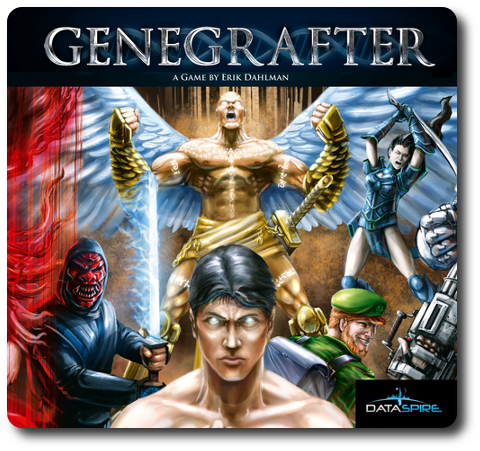
The Basics:
- For ages 7 and up (publisher suggests 13+)
- For 2 to 4 players
- Approximately 1o minutes to complete
Geek Skills:
- Counting & Math
- Logical & Critical Decision Making
- Reading
- Pattern/Color Matching
- Risk vs. Reward
- Hand/Resource Management
- Bluffing and Misdirection
Learning Curve:
- Child – Easy
- Adult – Easy
Theme & Narrative:
- Lead your secret army to win a secret war
Endorsements:
- Gamer Geek rejected!
- Parent Geek mixed!
- Child Geek approved!
Overview
Evolution is dependent on variants. A slight change to a gene here or a DNA strand there, and you have a different version of the norm. Sometimes these variants can result in beneficial mutations that help a species survive. In some very rare cases, it can elevate a species beyond anything we can imagine. There are those among us who are almost human. They fight for what they believe in or what you tell them to believe in. Lead your army of the strange to rule the world.
Genegrafter, designed by Erik Dahlman and published by Albino Dragon, is comprised of 54 cards, 6 blue standard six-sided dice, 6 red standard six-sided dice, 4 Player boards, 12 Attack tokens, and 12 Defense tokens. The artwork on the cards is excellent, portraying different mutants and their extraordinary powers. Some of the illustrations show violent acts, such as radiation poisoning and gamma ray blasts, but the illustrated violence is equal to the same you’d find in your mutant superhero comic books. For some, that’ll be fine. For others, it might be a concern. Look through the cards before playing the game with Child Geeks if you are not sure.
Game Set Up
To set up the game, first give each player 1 Player board, 3 Attack tokens, and 3 Defense tokens. The Attack and Defense tokens look like red and blue six-sided die. There is a space for both token type on the Player board. Player’s should place the tokens on their Player board now.
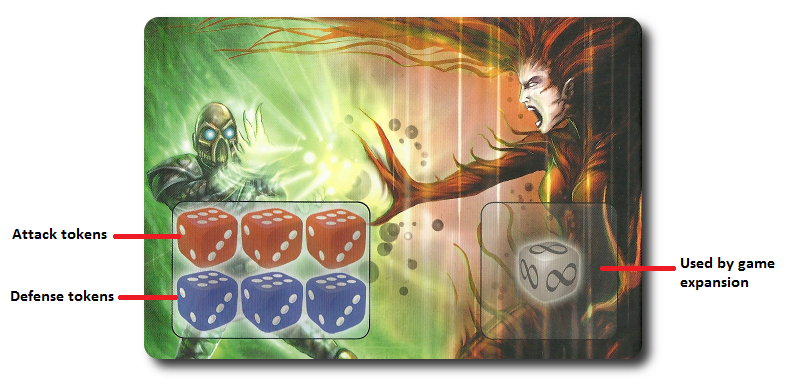
Second, look through the deck and remove the 3 “DNA Strand” cards and all the “Event” cards (Events have an exclamation icon on them). Set these cards aside.

“DNA Strand” card on the left, “Event” card on the right
Third, shuffle the remaining cards and deal 5 to each player, face-down. Players should pick up their cards and look through them, but keep them hidden from their opponents.
Fourth, shuffle the “DNA Strand” and “Event” cards back into the deck and place the deck, face-down, in the middle of the playing area. This is the draw deck for the duration of the game.
Fifth, place the dice to one side of the game playing area and within easy reach of all the players.
That’s it for game set up. Determine who should go first and begin.
A Secret War
Genegrafter is played in turns with no set number of turns per game. On a player’s turn, they will complete the following steps.
Step 1: Draw One Card
The player draws 1 card from the draw deck. The next action taken depends on the type of card drawn.
If the player draws an “Event” card, it placed face-up on the table for all the players to see and immediately resolved. Once the “Event” has been resolved, it’s discarded and a new card is drawn.
If the player draws a “DNA Strand” card, it’s placed face-up and to one side of the draw deck. The player now draws a new card.
If the player draws any other card, it’s placed in their hand.
Step 2: Play “Character” Card
If the player has a “Character” card in their hand, they must play it now. A player is always required to play at least 1 “Character” card per turn if they are able to. If they cannot, they are not penalized. If they have more than 1 “Character” card, they can play up to 3 on a single turn, but they are never required to play anymore than 1 per turn.
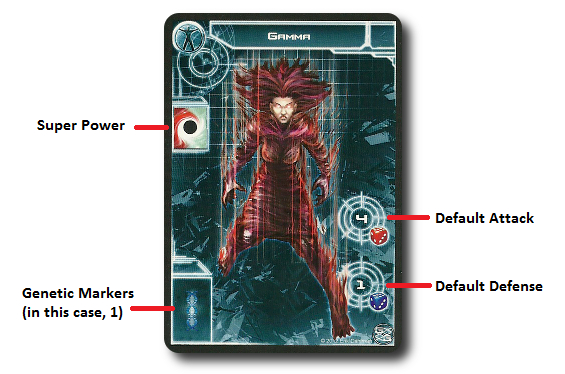
Gamma is a strong attacker, but not a great defender
“Character” cards are played face-up and above the Player board. We’ll call this the “Active Character” area.
Step 3: Battle
The player can now battle 1 or more opponents if they like. Battling is always optional.
To battle, the player announces which of their “Character” cards in their Active Character area they will be using and which opponent and opponent’s “Character” card they will be attacking. The player can only attack those opponents who have at least 1 “Character” card in their Active Character area.
Both players, starting with the defending opponent, now lay down 1 “Ability” card at a time, face-down, or removing 1 Attack/Defense token from their Player board. “Ability” cards will either provide an Attack bonus (red) or a Defense bonus (blue). If the “Ability” card matches the “Character” card’s Super Power, the bonus value is used instead (not added on to the standard “Ability” card value). If the “Character” card has the “Infinity” Super Power, they automatically match every “Ability” card’s listed Super Power. The Attack and Defense tokens add +1 die of the same color, regardless of Super Powers.
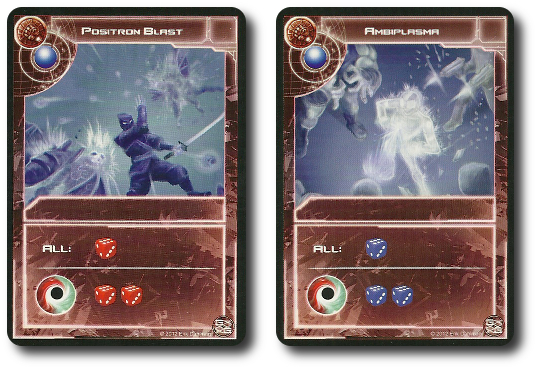
Both of these “Ability” cards match Gamma’s Super Power and provide more dice
This continues until both players decide to stop placing cards or tokens.
Then, starting with the defending opponent, each player flips over their last played card and resolves its effect one at time, alternating turns. Both players continue to do this until all the “Ability” cards are revealed.
Now players add up their dice bonus from the “Ability” cards and tokens. This number is added to their “Character” card’s Attack or Defense value. Note that the attacking player only ever counts the red Attack dice and bonuses and the defending opponent only ever counts the blue Defense dice and bonuses. All other bonuses and die colors are ignored.
The total number determines how many dice the players will roll. The attacking player rolls the red dice and the defending opponent rolls the blue dice. The total sum of the dice rolled is then determined and compared. The player who rolled higher wins the battle with ties going to the defending opponent.
The player who lost the battle now gives their “Character” card to their opponent. This “Character” card is placed in a special area next to the Player board referred to as the “Gene Pool”. Cards in the Gene Pool will be used at the end of the game to determine the winner. Finally, any “Character” cards that were damaged, but not yet removed, are given to the opponent who damage them.
Note: Some “Ability” cards allow players to heal damaged “Character” cards. If a damaged “Character” card is healed after a battle, it’s not given to the winner of the battle. Instead, it remains in the player’s Active Character area. Additionally, some “Characters” have the “Regeneration” Super Power. If these “Character” cards are damaged in battle, they are discarded instead of being collected into a player’s Gene Pool
All “Ability” cards played are discarded. All tokens used are returned to the game box.
The player is now welcome to battle another opponent if they like. Each opponent can only be attacked once per turn. Of course, if the player no longer has any “Character” cards, they cannot battle anyone.
Step 4: Discard
The player must now discard down to 7 cards, placing any cards they remove in the discard pile.
This ends the player’s turn. The next player in turn order sequence now goes starting with step 1 noted above.
Winning the War
When the third and final “DNA Strand” card is drawn, the game immediately ends. Each player now counts the number of Genetic Markers they have in their Gene Pool. Then players count the total number of Attack and Defense tokens they have on their Player board and divide it by 2 (rounding down). The total number of Genetic Markers is added to this number. The sum is the player’s score. The player with the highest score wins the game. If there is a tie, the player with the most “Character” cards in their Active Character area wins.
House Rules
In the event that a player is not dealt at least 1 “Character” card during game set up, they can elect to turn in their 5 cards and have 5 new cards dealt to them. This can only be done once per player and should be done before adding the “DNA Strand” and “Event” cards back into the deck.
To learn more about Genegrafter, visit the game’s web page.
Final Word
The Child Geeks really got into the theme of the game, gushing over the different Character cards, and talking excitedly about all the different abilities. They were continually frustrated when they couldn’t make their Character’s live up to their unrealistic expectations, however. According to on Child Geek, “I want my super bad guys to be more super bad.” The Child Geeks demonstrated complete understanding of how combat worked and how the game was won. They particularly liked that they had immediate access to abilities and bonuses, but didn’t like how often they couldn’t get more Character cards to use them. One Child Geek said, “Where are the people I’m supposed to battle with? I have the powers, but not the people who own them.” The game left the Child Geeks frustrated and flustered, but always happy enough to want to play another game. The Child Geeks voted to approve Genegrafter.
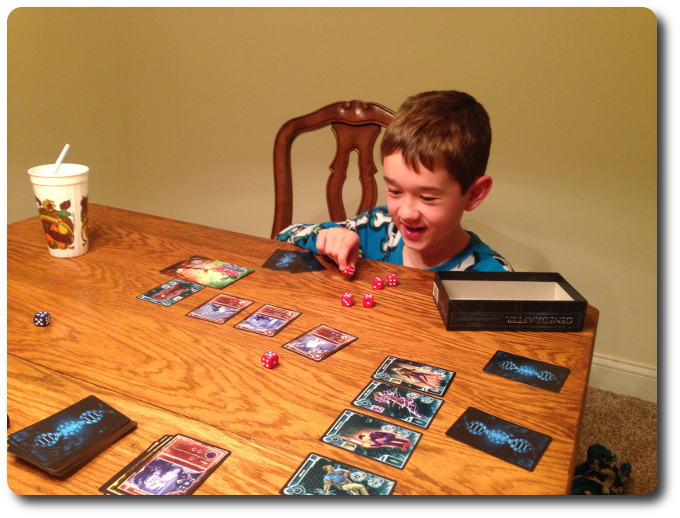
My son counts out his attack dice, clearly liking his roll – I don’t recall why he was on the ground…
The Parent Geeks were less impressed with the game, finding the same issues the Child Geeks did, but offering less in the way of forgiveness. One Parent Geek said, “This game feels way to random to me. I can’t make any plans of attack until I get cards and I often don’t have the cards I need.” Another Parent Geek said, “This is one of those games I think is perfect to play with my kids or with my friends who just want a quick game without much fuss. This is a really easy game to play.” The Parent Geek non-gamers and casual players found Genegrafter to be an entertaining and light game that didn’t take much time or thought to enjoy. The Parent Geeks who like a bit more interactive and deep game play found Genegrafter to be too light and too random to be of much interest. The result was a mixed approval from the Parent Geeks.
The Gamer Geeks were very excited to play the game. Genegrafter has beautiful illustration, excellent component quality, and a theme that would get any geek excited. Once the game was started, the mood quickly began to shift. One Gamer Geek said, “This is the fourth time I’ve drawn nothing but abilities and not a single Character card. But look how many you have. Seven. Seven characters and I have none. That’s stupid.” Another Gamer Geek said, “This is just a random game where you are randomly selecting a card, randomly rolling dice, and attempting to offset your odds by adding more randomness. That’s not really a game I enjoy.” But not all the Gamer Geeks were disliking the game. One Gamer Geek said, “I think this is a very shallow and light game, but that’s perfect for a game filler or when you just want to play a game without putting much thought into it.” Not enough Gamer Geeks agreed, however, and the Gamer Geeks voted to reject Genegrafter.
This game can be a bit frustrating at times. I have played and observed enough games to know that it’s completely possible that players won’t have Characters or only 1 player has Characters. In both cases, no combat can be initiated. A simple house rule fixed this in the beginning, but the issue can pop up again midway through the game. It didn’t happen a lot, mind you, but it happened enough times to leave an impression.
Unfortunately, I think this game suffers from its outside appearance. Genegrafter is a beautiful looking game. Colorful, stylized, and well designed. It looks epic, but looks can be deceiving. Genegrafter is not an epic game, although it does use epic characters as part of its narrative. This narrative never transcends any further than the artwork, however, and the player is left playing a game that feels rather mundane. With 18 different special abilities, you’d think there would be more stylized combat, but this is not the case. The game left me feeling like it was half done, or better put, not fully realized. There’s potential here, but I don’t think the game reached it.
Where does that leave us? Genegrafter does make a great deal of use of logical thinking and players do have to bluff. Laying down more Ability cards than you can use gives your opponent the false impression that you are beefing up for a big battle when you could only be tricking them to spend cards. There isn’t a lot, but players do have to exercise light hand management and take risks to get the bigger rewards. There is a game here, despite what some Gamer Geeks think. It’s just that the game itself is not overly complicated and plays quickly, leaving players wondering if they enjoyed their 10 minutes with the game or want the 10 minutes back. I suggest you try for yourself and decide if the 10 minutes was well spent.
This game was given to Father Geek as a review copy. Father Geek was not paid, bribed, wined, dined, or threatened in vain hopes of influencing this review. Such is the statuesque and legendary integrity of Father Geek.



